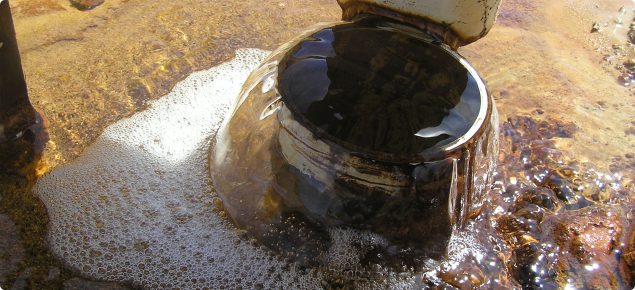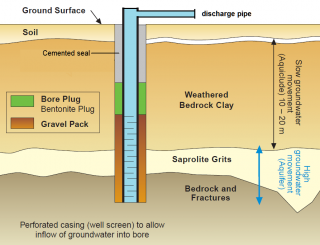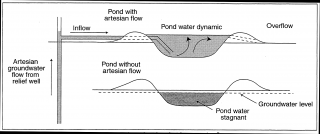This activity is covered by legislation
An owner or occupier of land must give at least 90 days notice to the Commissioner of Soil and Land Conservation of an intent to drain subsurface water to control salinity and discharging that water onto other land, into other water or into a watercourse, even if on the same property. The notice must be in writing using the notice of intent to drain or pump (NOID) form. Principles and guidelines for inland drainage are covered in the Policy framework for inland drainage.
Artesian wells require a licence from the Department of Water and Environmental Regulation: a 26D licence is issued under the provisions of Section 26D of the Rights in Water and Irrigation Act 1914 to construct or alter wells. A 26D licence is required to:
- commence, construct, enlarge, deepen or alter an artesian well [26A(1)].
Relief wells for managing waterlogging and salinity
Relief wells are usually placed low in the landscape, often in the waterlogged or saline area, and they:
- can reduce the severity and extent of local discharge from 'leaky' aquifers at small saline seeps
- produce a discharge that may be suitable for livestock water, but excess water must be disposed of safely to reduce problems downstream
- cannot lower the hydraulic head below the soil surface, or below the height of the bore casing projecting above ground
- cannot prevent all waterlogging or surface saline soils.
The advantages of relief wells
Relief wells, as for pumping and siphon wells, take very little space for the resource protection they provide. Like siphons, they are cheap to operate. However, they only work where there is confined or semiconfined groundwater with a hydraulic head (piezometric or potentiometric head) above the ground surface. Pumps can be fitted to relief wells – in the right conditions – to increase discharge.
How relief wells work
These are called relief wells because they relieve the hydraulic head by allowing faster or more managed discharge.
Relief wells rely on artesian pressure – within a confined or semiconfined aquifer at depth – to force groundwater up a bore casing to the ground surface. The flow from a relief well depends on the artesian pressure and the permeability of the aquifer.
Strong artesian pressures usually range from 1 to 8 metres (m) above ground level.
Artesian pressures exist where groundwater flow is restricted or 'slowed down' along its path down the gradient. Typically, this occurs on hillsides where dykes or fracture zones intersect sloping land, and occasionally in valleys in high rainfall areas.
Sedimentary aquifers overlain by clay sediments have recorded pressures of 6m above ground level. In south-west Western Australia, typical artesian aquifers consist of sandy weathered rock or gritty sedimentary beds, or as fracture sets contained within the underlying bedrock (granite and dolerite).
In most areas where artesian pressure can be found, a suitable aquifer (sand or bedrock fractures) can be expected 10–25m below ground level.
For a relief well to produce the best possible flow rate, drilling:
- should occur directly over the site that exhibits artesian pressure
- must penetrate a permeable aquifer (sand or bedrock fractures) at depth.
Best site for a relief well
The best site is where there is sufficient artesian pressure. Groundwater discharge areas are more likely to be artesian where local surrounding slopes are greater than 1.5–2%, to provide the hydraulic head.
Finding sites with artesian pressure sites can sometimes be a problem; groundwater discharge can be a guide:
- saline areas that appear out-of-place in the landscape, such as in undulating terrain where isolated groundwater discharge (salt-affected) areas are located on a hillside
- areas containing isolated seepage eyes, which may have a significant perennial or seasonal flow
- upslope from dolerite dykes or other constrictions
- in faults and sloping sedimentary valleys in medium to high rainfall areas.
Testing for artesian conditions
Drill a test hole (about 40 mm in diameter) to test for artesian conditions. In most cases, drilling a 6–10 m deep hole will show if artesian conditions exist. In some sedimentary areas, holes deeper than 10–30 m are required.
Artesian pressure will be apparent if the water level within the hole (or piezometer if casing is installed) rises above ground level. Water levels in the hole will rise within minutes if into an artesian site, or may take several hours or up to a day to rise to the maximum if the hole is drilled into clay soils.
Relief well construction
New or altered artesian wells require a licence from the Department of Water and Environmental Regulation. Because of the artesian pressure, special care is needed to prevent leakage (see Figure 1).
Low artesian pressure (less than 3 m)
Once a bore is drilled, a length of perforated casing is inserted to a depth that intersects the aquifer. A pack of permeable gravel is then inserted around the perforated casing to allow the maximum possible volume of groundwater to enter the bore casing. A plug (usually containing cement and bentonite) must be packed above the gravel to prevent groundwater from rising up the outside of the casing. To prevent leakage, this may need to extend to the soil surface.
High artesian pressures (greater than 3 m)
Before drilling into a strongly artesian aquifer, a large diameter casing (125 mm or greater) needs to be cemented into a large bore (at least 200 mm diameter), in a position above the zone of pressure and left to set. Drilling can then proceed inside the casing and the well can be capped if required.
Relief wells are usually established with a 100 mm bore hole (drill diameter) with a 50 mm PVC casing fitted into the hole (Figure 1).
Note: The costs here are indicative only, and need to be checked before making any commitment.
A typical relief well with a drilling diameter of 100 mm, installed using 50 mm diameter casing, to a depth of 25 m is estimated to cost $2500–3000. Very high pressure artesian systems have higher leakage risks, and establishing a relief well may cost twice the typical estimate. A pipeline and related fittings is expected to cost an extra $500–1000. Not all bores deliver good flow, and therefore drilling budgets should allow sufficient funds for additional bores.
Groundwater supply of relief wells
A typical relief well in south-west Western Australia will yield between 4000 and 15 000 litres per day (L/d). Maximum rates of more than 1 litre per second (86 400 L/d) have been achieved.
The yield from relief wells is usually constant throughout the year. Following very dry years, yield can fall by 10–20%, and then recover after normal to wet years. Yield can also fall as a result of pumping elsewhere in the aquifer, clogging of the intake screen, and revegetation water use in the catchment.
Using relief wells
Saline seep management
Dryland salinisation is caused by the discharge of saline groundwater. However the slow 'speed' of groundwater movement and high rates of evaporation worsen the impact. Irrespective of the volume of groundwater discharge, the slower the rate, the larger the area affected by dryland salinity.
The environmental impact of large areas being exposed to saline groundwater discharge is compounded by evaporation within the shallow profile. Evaporation increases the concentration of salt salinity) in the groundwater discharge area (secondary enrichment).
A relief well is one method to increase the rate that groundwater can be discharged at a site. The purpose is to reduce the area affected and the range in discharge area and stream salt concentrations.
It is important to note:
- Relief wells can only function in areas of artesian pressure, and cannot prevent dryland salinisation by themselves.
- Relief wells are most effective in reducing the impact of dryland salinity on localised hillside seeps; if the topographic gradient is greater than 1.5%, groundwater siphoning may be more efficient.
- The benefit of using relief wells is increased if the water can be productively used, for example, for aquaculture, stock watering, irrigation.
Improving the efficiency of rural aquaculture ponds
Some methods of inland aquaculture rely on shallow groundwater seepage to maintain sustainable water levels within excavated earth ponds (Figure 2). Artesian groundwater flow from relief wells can be used to actively replace shallow groundwater to improve or maintain the quantity and quality of pond water.
Using artesian flow within excavated earth aquaculture ponds ensures the water is cleaner, at a more stable temperature, and allows good control of water levels within the pond.
Enhancing riparian health and diversity
Riparian (river) environments exposed to discharge from saline seeps may benefit from relief wells, siphons, pumping and other forms of drainage, because managed discharge may:
- decrease the salt concentration of groundwater discharge entering the riparian environment – the salt load remains more stable, with an increase in discharge volume
- decrease the variation in salt concentration and the variation in discharge volume of the groundwater –reduced surface area of groundwater discharge reduces the volume of groundwater evaporation, which is especially important during dry summers.
When conditions are appropriate, relief wells may be able to stabilise discharge areas and allow salt-tolerant populations of flora and fauna to establish.
Reading
- Salama, R, Ali, R, Pollock, D, Rutherford, J & Baker, V 2003, Review of relief wells and siphons to reduce groundwater pressures and water levels in discharge areas to manage salinity, A report to Water & Rivers Commission, WA, CSIRO, Australia.
- Seymour, AJ & George, RJ 2004, 'The process and environmental impact of bore siphons in mitigating dryland salinisation', in Proceedings of 1st National Salinity Engineering Conference "Engineering Salinity Solutions", 9–12 November, Perth, Western Australia, viewed 8 November 2018, accessed 13 September 2022.




